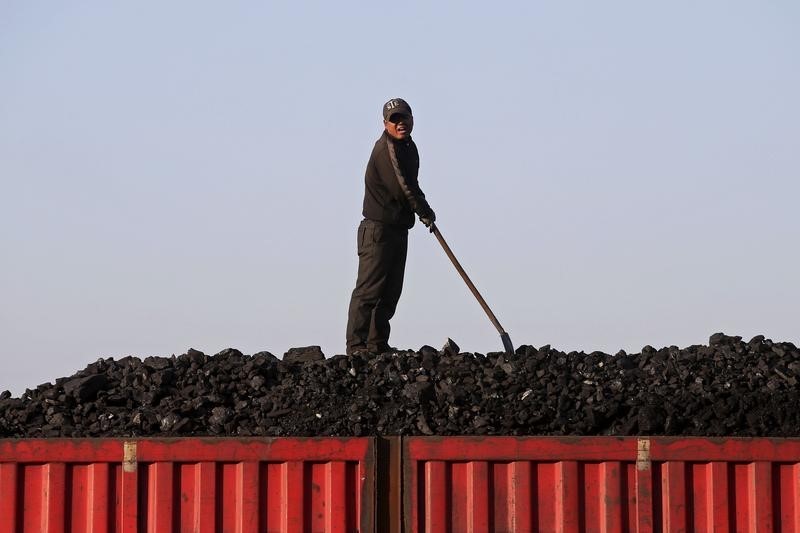(Repeats earlier story for wider readership with no change to text. The opinions expressed here are those of the author, a columnist for Reuters.)
By Clyde Russell
LAUNCESTON, Australia, Nov 14 (Reuters) - One thing becomes absolutely clear when reading the IEA's latest World Energy Outlook; if the world is to have even the remotest chance of making its climate goals, then China and India are going to have to do something about their coal use.
The International Energy Agency's report said coal is responsible for 30% of all energy-related carbon dioxide emissions, making it the biggest single contributor.
If the world is to limit the increase in temperature as a result of climate change to less than 2 degrees Celsius (3.6 degrees Fahrenheit), it's clear that coal consumption will have to be reduced far more dramatically than is currently forecast.
The IEA report outlined three scenarios for energy use up until 2040, namely current policies, stated policies and the sustainable development scenario.
The latter two are the more important as stated policies refers to what is likely to happen on the basis of announced government policies and plans, and sustainable development is the path needed to meet the climate goals.
Coal was responsible for 14.66 billion tonnes of carbon emissions in 2018, and the IEA said that under the stated policies scenario this will only drop slightly to 14.34 billion in 2030 and 13.89 billion in 2040.
However, the sustainable development path calls for coal's carbon emissions to plunge to 8.28 billion tonnes by 2030 and 3.4 billion by 2040.
The gap by 2040 between the stated policies and the sustainable development is a massive 11.24 billion tonnes, which to put in context is almost the total amount of carbon emissions created in 2018 by using crude oil, and almost 60% higher than the emissions from natural gas.
If the world is to move to the sustainable development scenario, it means a dramatic shift away from coal and towards renewable energy across the globe.
But in practical terms, the future of coal is largely in the hands of just two countries, China and India, which currently account for 60.2% of global electricity generated by the polluting fuel, according to data from the Institute for Energy Economics and Financial Analysis (IEEFA).
CHINA, INDIA ARE COAL
The United States accounts for 11.1% and the European Union for 5.2%, but coal burning is declining rapidly in both, mainly as a result of cheap natural gas in the United States and the rising penetration of renewables in Europe.
The IEA said that under its stated policies scenario China's coal use goes from 2.83 billion tonnes of coal equivalent to 2.84 billion in 2030 and 2.57 billion by 2040, but under the sustainable development path it would need to drop to 2.07 billion by 2030 and 1.15 billion by 2040.
India's demand was 586 million tonnes of coal equivalent in 2018, and the IEA forecasts this to rise to 938 million by 2030 and 1.16 billion by 2040 under the stated policies scenario, but to meet the sustainable development scenario it would need to be 546 million.
What the IEA suggests is that India effectively needs to limit its coal demand to current levels, and China will have to cut its consumption by some 60% by 2040.
This would require a major change in policy direction in both countries, something that would be difficult to achieve, both politically and financially.
India perhaps offers more hope given the country is already embracing renewable energy, given it is now cost-competitive with coal-fired generation.
The well-publicised pollution problems afflicting many Indian cities may also drive a shift away from coal, especially if public discontent increases.
For China the challenge is harder, given the size of its coal sector and the subsequent cost of shifting away from the fuel.
The IEA suggests China may be able to deploy carbon capture and storage systems on a large scale, but this would be costly and there is currently little political impetus to make this happen.
Replacing coal with renewables, hydro or nuclear will also be expensive, especially since the sustainable development path would mean retiring many coal-fired power plants well ahead of their normal lifespan of about 50 years.
It is of course possible to take a different view of the IEA's forecasts, but no matter which way the world's energy future is sliced and diced, the fact remains that coal consumption will have to drop sharply to meet climate change goals.
It's also a fact that the world is largely reliant on this happening in just two countries, but not just any two countries.
China and India are the world's most populous nations and are still developing economically, making them energy hungry.
They also have vast domestic coal resources and the technology to mine them and burn them in locally-engineered power plants.
Weaning these two nations off coal is looming as the real challenge for climate activists. (Editing by Christian Schmollinger)
